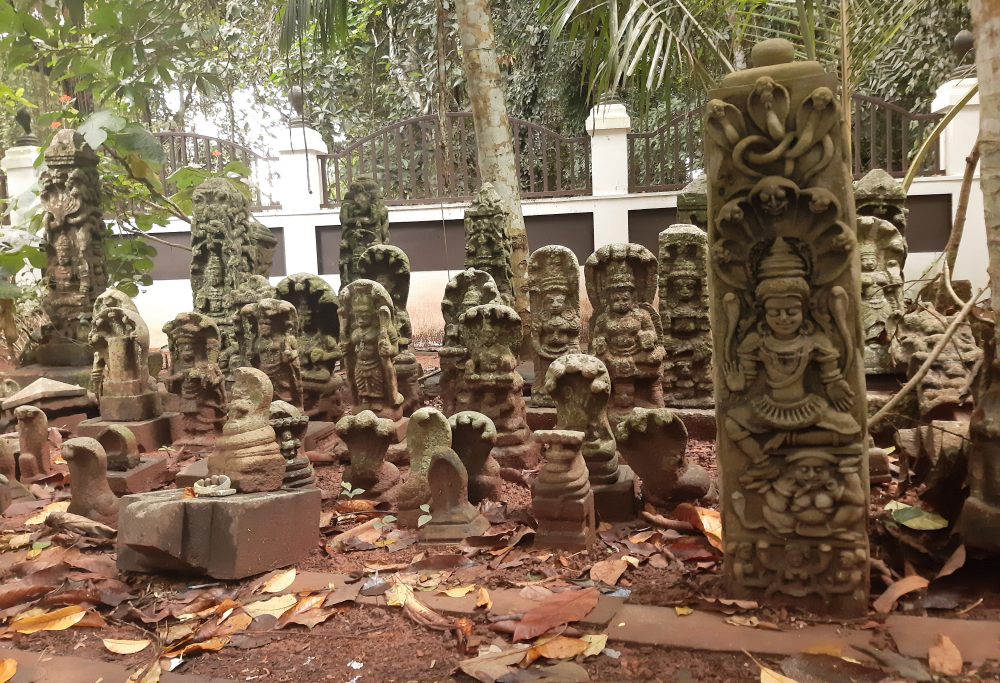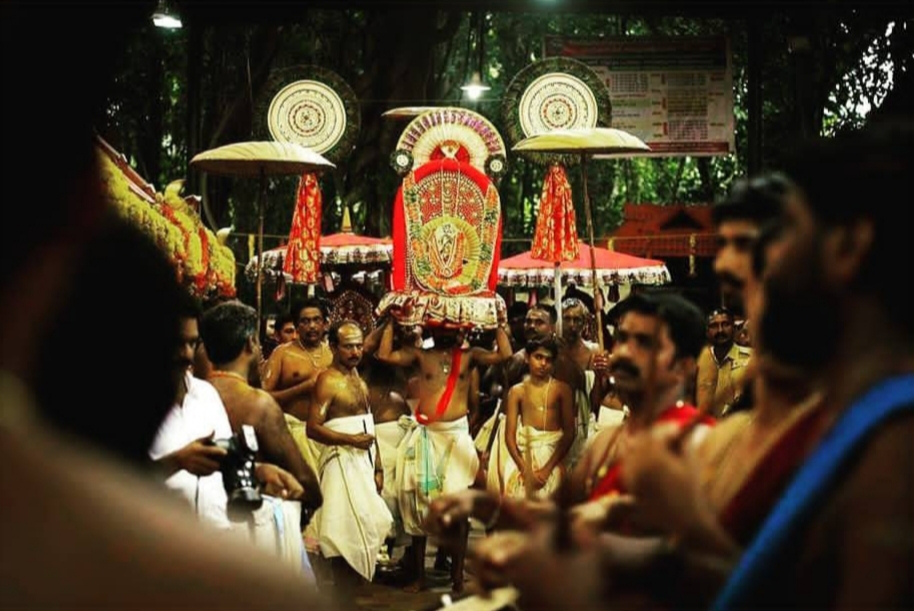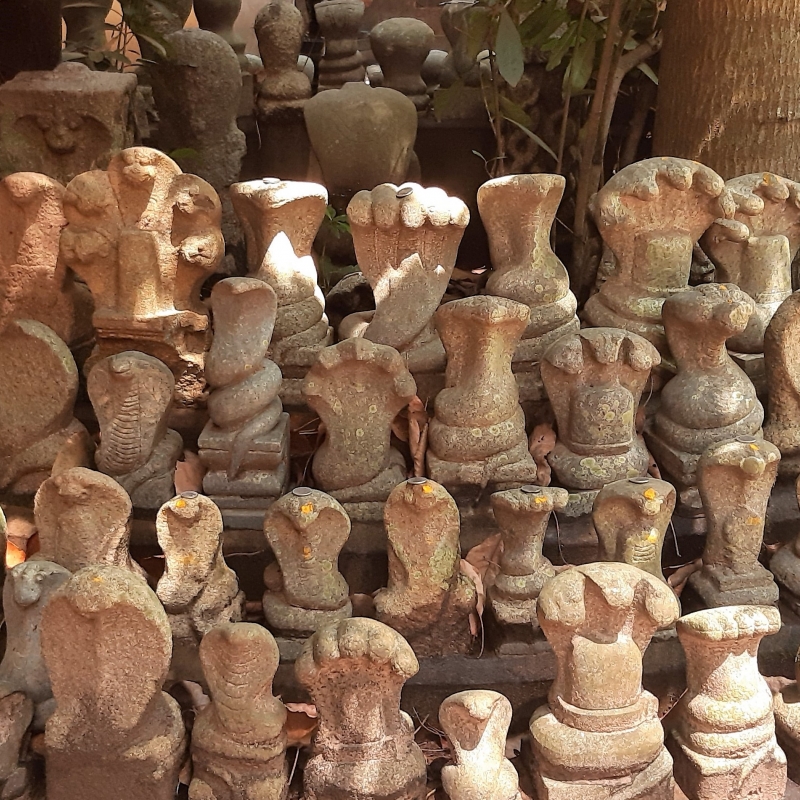Serpent worship or ophiolatry is intricately woven into Hindu mythology and forms a significant part of the culture and belief systems of Kerala. Architectural historian James Fergusson in his book Tree and Serpent Worship writes that the serpent played ‘…an important part in the mythology of India, and [its] worship not only prevailed, but considerably influenced forms of faith.’[1]
The origin of serpent worship in Kerala dates back to the account of the origin of the state itself. According to a legend, Lord Parasuram threw his axe into the sea, and the sea withdrew itself from the part where the axe landed, letting Kerala emerge. However, the salinity of the land made it infertile and uninhabitable. Parasuram then prayed to Lord Shiva for a solution, and was suggested to seek the help of Nagaraja (king of serpents).[2] Thus, he went to the southwest shore of Kerala and started doing penance to please Nagaraja. Delighted by the devotion of Parasuram, Nagaraja Anantha appeared before him, and said that his serpents would desalinate the soil by spitting their venom on it, thereby making the land fertile. Ever since, the people of Kerala consider serpents the protectors of land. Most traditional Hindu families in Kerala own sarppakavus (serpent groves) of their own where pujas are held and offerings given occasionally.
Vetticode Aadimoolam Sree Nagaraja Temple
Vetticode temple is believed to be one of the first two snake temples envisaged by Lord Parasuram, the other being Mannarassala Nagaraja temple. Legends say that after the serpents helped in making the land fertile, Parasuram decided to thank the serpents by giving them a piece of land to saunter undisturbed and uninhabited by human beings. Pleased by the devotion of Parasuram, Nagaraja Anantha appeared before him and blessed the land with the divinity of his presence. It is believed that the idol for the temple was made by Mayasura, the asura architect; the consecration of the temple of Vetticode was also blessed by the presence of Brahma, Vishnu and Shiva. Since the land for the temple was mounded by Lord Parasuram using his axe, it later came to be known as Vetticode, which literally translates into heaped land, and since it was the first serpent temple of Kerala, it is known as Aadimoolam (aadi meaning first).[3] There are two ponds near the temple from which Lord Parasuram is believed to have heaped the soil; the rare species of medicinal plants surrounding the ponds impart a medicinal quality to its water.[4] It is widely held that taking a bath in these ponds can be helpful for many skin diseases.
These serpent temples in Kerala are usually looked after by ‘protector families’, and the protector family of Vetticode temple is Meppallil Illam (a local Brahmin household). Illam is a traditional Brahmin household of Kerala, and its karanavar (the senior-most member of the family) leads an ascetic life dedicated to the temple and nagaradhana (serpent worship); the present karanavar of the temple is Sri Parameswaran Nampoothiri.[5] It is believed that Parasuram himself has appointed the Meppallil family as the serpent protectors.
The Vetticode temple has more than 100 serpent idols which were brought from various places (Fig. 1); this is because many families find it difficult to maintain and protect sarppakavus, so the deities from such places are put in serpent temples like Vetticode following a practice called kavumattom (change of sarppakavus) or sarppakarshanam (attracting serpents).

The major festival of the temple falls on the ayilyam (ninth star of Hindu astrology) day of the Malayalam month Kanni (coinciding with September and October of Gregorian calendar). According to Puranas, the month of Kanni is special in serpent worship because it is the month in which the serpents wake from their meditation. The festival begins to the beats of musical instruments such as kombu (a long and curved horn-like instrument), kuzhal (a South Indian variation of aerophone) and chenda (a cylindrical percussion instrument) to entertain the Nagaraja. This is followed by a ceremonial procession known as ezhunnallathu, in which the priest carries the idol of Nagaraja from the temple to Meppallil Illam.[6] (Fig. 2)

Mannarasala Sree Nagaraja Temple
Mannarasala Sree Nagaraja temple is located at Harippad in the southeast district of Alappuzha, Kerala. It is surrounded by lush green sarppakavus which are home to many exotic species of medicinal plants and reptiles. The kavus (groves) as well as the temple are also host to many serpent idols.
According to legends, the place where Parasuram did penance to please Nagaraja became the temple of Mannarasala. The place was surrounded by mandara (ethyrina) trees. When the Nagaraja appeared before Parasuram, he agreed to reside there and eternally bless the land with his presence. Thus, the abode of Nagaraja among the mandara trees came to be known as mandarasala (abode amidst the mandara trees), which later became Mannarasala. The temple has been protected over the centuries by members of Mannarasala Illam.
Unlike most of the temples in Kerala that give importance to male priests, the Mannarasala temple has a centuries-old unique system of worship in which the eldest female member of Mannarasala Illam becomes the chief priestess; the priestess is succeeded by the second eldest female member of the family. The high priestess is called amma (mother); when a woman is appointed as the next amma, she takes a vow of celibacy and adopts an ascetic lifestyle for the rest of her life.
There is a story associated with this system of worship in Mannarasala. Centuries back, there was a huge fire in the kavus surrounding the temple; the serpents in the kavus were injured and burnt. The inhabitants of Mannarasala Illam at the time, Vasudevan and Sreedevi, nursed the serpents back to health with utmost care and devotion. Nagaraja was gratified by this act of the couple, and blessed them with two children. He said that he himself would incarnate on earth as one of their sons. Thus, Sreedevi gave birth to two sons, a human child and a naga child. When both the children entered adulthood, Nagaraja advised his brother to marry and preserve the lineage of the illam. Then, Nagaraja went inside the nilavara (a small cellar inside the house) and started meditating; however, the separation from her son deeply saddened Sreedevi, seeing which Nagaraja allowed her to get into the nilavara once a year and conduct pujas for him. Since then, the main pujas and ceremonies for Nagaraja are conducted by the ammas of Mannarasala Illam. The belief that Nagaraja meditates inside the nilavara of Mannarasala Illam persists even today, and people respectfully call him appoppan (grandfather).[7]
Pambummekkattu Mana
Earlier, Pambummekkattu Mana was simply known as Mekkattu Mana. There is an interesting myth behind the addition of the pambu (snake) to Mekkattu Mana. There was a time when the Mekkattu family suffered from severe poverty and misery. The head of the family, Mekkattu Nampoothiri decided to perform penance at Thiruvanchikulam temple of Eranakulam; he stayed there and meditated for almost 12 years. One night, when he went to the pond to collect water, he saw a stranger holding an unusual gem in his hands. The stranger said that it was nagamanikya (serpent stone), a rare and mythical gem, so precious that its price is undeterminable. When Mekkattu Nampoothiri expressed his desire to see the gem closer, the stranger tossed it into his hands. Even though Nampoothiri knew that the gem would relieve his family from poverty and make them rich, he gave it back to the stranger. The next day, Nampoothiri saw the stranger again and requested him to reveal his true identity. The stranger revealed himself as Vasuki, the serpent who serves as the garland of Lord Shiva and is also known as one of the kings of serpents. Mekkattu Nampoothiri besought Vasuki’s presence at his illam; Lord Vasuki then manifested in the kizhakkini (eastern room) of Mekkattu Illam and gifted the nagamanikya to Nampoothiri. Since then, Nagaraja Vasuki and his wife, Nagayakshi are worshipped in the kizhakkini of Mekkattu Mana or Pambumekkattu Mana as it is known now. The kizhakkini has an oil lamp known as kedavilakku (the lamp that never blows out) which is perpetually aflame. Just like the kedavilakku at Vetticode temple, the oil and ash from the lamp at Pambummekkattu Mana are considered auspicious and given as prasad to devotees; they are also considered remedies for skin diseases such as psoriasis.
Notes
[1] Fergusson, Tree and Serpent Worship, 72.
[2] The kings of serpents are known as nagaraja. There are mainly three serpent deities who are entitled to this position: Anantha, Vasuki, and Takshaka. They are among the thousand naga children of sages Kashyapa and Kadru.
[3] Venugopal Nampoothiri of Meppallil Illam, priest of Vetticode Nagaraja temple, in conversation with the author, September 21, 2019.
[4] Manappattu, Mannarasala Sree Nagaraja Sandhyanamam, 12.
[5] Infokerala Communications Pvt Ltd, Pilgrimage to Temple Heritage, 156.
[6] Ibid.
[7] Dr Seshnag M. P of Mannarasala Illam, in conversation with the author, September 25, 2019.
Bibliography
Fergusson, James. Tree and Serpent Worship. Chennai: Asian Educational Services, 2006.
Iyer, Sreenivas S. Sree Nagaraja Stotrangal. Thiruvananthapuram: Avani Publications, 2018
Infokerala Communications Pvt Ltd. Pilgrimage to Temple Heritage. Infokerala Communications Pvt Ltd, 2017.
Kumar, Suresh. ‘Serpent God Worship Ritual in Kerala.’ Indian Folklore Research Journal 5, no. 8 (Dec 2008): 104–121.
Manappattu, Padmakumar. Mannarasala Sree Nagaraja Sandhyanamam. Mannarasala: Manasa Publications, 2003.

